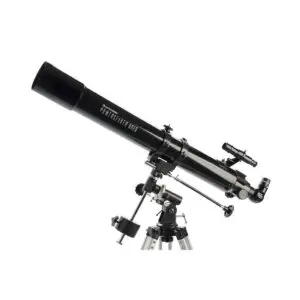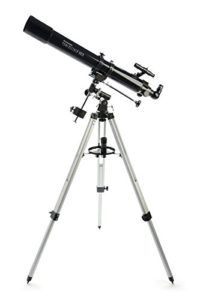
The Celestron PowerSeeker 80EQ is a refractor telescope with an 80mm aperture being part of the same PowerSeeker range as do the 60EQ, 70EQ, 127EQ and 114EQ.
Click here to check price and availability
Compared to the other telescopes for the same PowerSeeker EQ range it’s situated in the middle with the 127EQ and 114EQ having the larger apertures and thus delivering higher power but with a corresponding price point while also being newtonian reflectors and not a refractor as is this telescope. But the 80EQ is more powerful than the 60EQ and 70EQ being able to deliver more cleared and crisper images and both.
-
Manufacturer - 9.9/10
9.9/10
-
Optics - 9.7/10
9.7/10
-
Value - 9.7/10
9.7/10
In many ways this telescope is a perfect combination between power and price, making it a great choice for the beginner astronomer who want’s to get into astronomy and have a telescope that will be able to provide enough power to keep you entertained for more than a few viewings and allow you to discover the night sky for years to come while also keeping the price at a value at which it represents value.
You’ll find the following components in the box: the optical tube, equatorial mount, finderscope, 2 eyepieces (20mm, 4mm), 3x barlow lens, aluminium tripod and a copy of the SkyX software.

The assembly and setup of the telescope takes less than 10 minutes and is pretty straight forward, and if you have any additional questions on how the equatorial mount works there is a very useful guide included and the software also has a step-by-step guide to setting the telescope up and complete your first viewing. And speaking of the SkyX – First Light Edition software, it’s very useful in guiding you on what celestial objects you can view and when and where. It contains a 10,000 objects database having printable sky maps and 75 enhances images available.
Once set up, I found the telescope setup to be surprisingly sturdy comparing to other telescopes that include an aluminium tripod. The tripod also contains an accessory tray which is very useful in order to keep all the accessories and eyepieces close at hand and organized.
When choosing a telescope mainly for astronomy you should choose one with an equatorial mount, as the 80EQ has, as it makes the tracking of celestial object very easy. Once you’ve found the object you want it’s just a matter of turning a knob to keep the image centered. There is also the option of adding a motored drive which keeps the image centered automatically.
The optics are great delivering bright and clear images while also having erect images which means you see the objects in their correct position and not upside down and horizontally flipped. This feature allow this telescope to be used for terrestrial viewing as well.
Overall a good to great telescope that will deliver excitement for the new as well as the initiated astronomer.
The pros of the Celestron PowerSeeker 80EQ:
The aperture and focal length produces stunning images of night sky objects. The optics are of great quality receiving the 2013 optics Brilliance awards. You can see the moon’s craters, Jupiter, Saturn as well as get views on deep-sky objects like galaxies and nebulae. The equatorial mount is perfect for this particular telescope and it makes tracking objects as they move across the sky really easy and precise.
The cons of the Celestron PowerSeeker 80EQ:
As an entry level telescope, the 80EQ does not have any clear cons to it. It delivers value for it’s price. Other reviews have complained about the tripod not being sturdy enough and the fact that the finderscope along with other components are made of plastic. However despite these facts, we found the tripod to have great stability and the plastic components do not subtract from the overall quality feel that the telescope gives. One other cons might be the portability as the dimensions of the optical tube does not allow for this telescope to be backpacked, but the overall weight is relatively low.
Click here to check price and availability
Full technical specification:
Optical Design: Refractor
Aperture (mm): 80 mm (3.15 in)
Focal Length: 900 mm (35 in)
Focal Ratio: 11
Focal Length of Eyepiece 1 (mm): 20 mm (0.79 in)
Magnification of Eyepiece 1: 45 x
Focal Length of Eyepiece 2 (mm): 4 mm (0.16 in)
Magnification of Eyepiece 2: 225 x
Barlow Lens: 3 x
Finderscope: 5×24
Star Diagonal: 1.25″ Erect Image Diagonal
Mount Type: German Equatorial
Accessory Tray: No-Tool Tray with Eyepiece holder
Tripod: Aluminum
Highest Useful Magnification: 189 x
Lowest Useful Magnification: 11 x
Limiting Stellar Magnitude: 12
Resolution (Rayleigh): 1.74 arc seconds
Resolution (Dawes): 1.45 arc seconds
Light Gathering Power (Compared to human eye): 131 x
Apparent Field of View: 1.2 °
Linear Field of View (@1000 yds): 61 ft (19 m)
Optical Coatings: Multi-Coated
Optical Tube Length: 38 in (965 mm)
Total Telescope Kit Weight: 19 lbs (8.62 kg)
